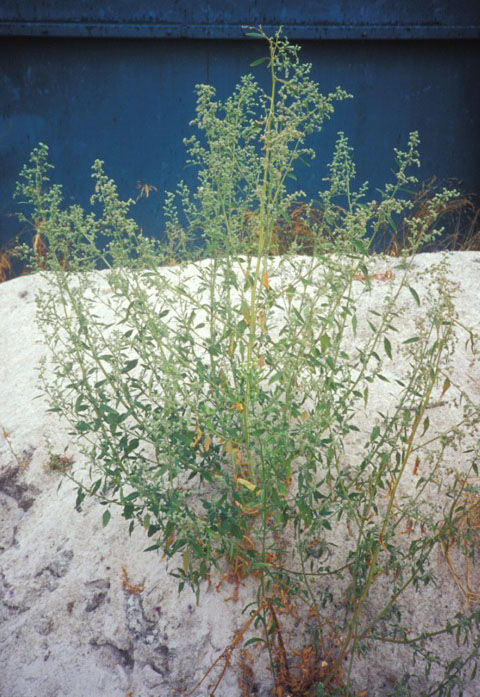
|
| Lambsquarters; Chenopodium album L. |
Goosefoot Family; CHENOPODIACEÆ
|
| Lambsquarters is a summer-annual herb, sprouting late in spring, growing strong from summer warmth, finally killed six months
later by autumn frost. It assumes tree-like form of a single stem beset with many ascending branches, all bearing soft, usually lobed leaves.
A dusty whitish, mealy, finely scurfy powder coats parts of the plant. Dull, negligible, wind-pollinated flowers of microscopic size give
rise to copious tiny dark seeds. In rich, disturbed soil, a strong Lambsquarters can attain ten feet tall; most reach three to six feet. Black
aphids are frequently found feasting on it. |
| Lambsquarters originated in the Old World, and now grows globally almost wherever humans dwell. Being such a
successful competitor-plant makes it one of the world's worst weeds, yet withal few plants are so valuable. In effect, it is a wild vegetable crop,
quite worthy of cultivation. Close relatives include Spinach, Swiss Chard, Beets, and the lesser known Good King Henry, New Zealand
Spinach, and Quinoa. Compared to most leafy greens, it is particularly rich in protein, fat, calcium, phosphorus and Vitamin A. Besides
being nutritious, its flavor and texture are distinctive and delicious, and it is good eaten raw or cooked. Both the greens and the seeds are
sometimes eaten. |
| Lambsquarters is a scrawny little weed if its soil is hard; plump and large if the soil is loose or disturbed. You can pull it up in
either case. Control consists in composting it before the seeds ripen. |
Other names include: White Goosefoot, Dirty Dick, Wild Spinach, Dirtweed, Fat Hen, Smooth Pigweed, Mealweed, Frost Blite,
and Bacon Weed. In the Language of Flowers it signifies "Goodness."
|
Originally published as the Seattle Tilth newsletter Weed of the Month in August 1986, along with an illustration drawn by Jerri Geer.
Back |
|
|

